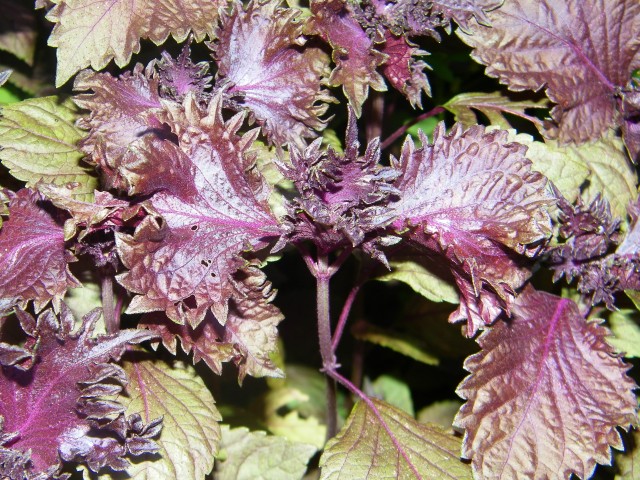QuestionQUESTION: First, thank you for taking the time to answer my questions.
I planted 8 different varieties of basil in my garden last year including sweet, bush, several different flavors, a bunch of purple ruffles, and one holy. This year, only one basil survives, and it is like no basil I have ever seen. They are in the same place as the one holy basil (all 50+ of them), but exhibit some very interesting and distinct qualities. Most important is that its general characteristics strongly resemble the holy basil, but it has very, very ruffled leaves with a deep purple/pink/burgundy pigment. Mixed in with the purple pigment, however, is some turquoise and gold that has somehow managed to produce a highly iridescent surface. Many of the seedlings started out spotted green and purple like you would expect from purple varieties, but after a few weeks, all of them are now a uniform iridescent purple/gold/turquoise (even the ones that were spotted).
If you are interested, I have some stunning pictures that I am uploading to photobucket tomorrow.
My questions:
Could this be a true hybrid of two different species?
Can holy basil take qualities from other species of basil without hybridizing per se(and vice versa)?
How can I tell?
Most important; have you ever seen or heard of an iridescent basil (or any herb for that matter)?
ANSWER: Hi Seth,
Thanx for your question and you are most welcome. I enjoy participating in this service. Yes, I would like to see some pictures of your plants. I believe you are looking at some plants that may have hybridized from your mix of basils. Basil is like any other plant and can be manipulated or hybridized to produce new and unique features. Anytime an organism takes on qualities of another set of genes, it is in effect hybridizing so it is not true to form anymore. If you had two Arkansas Traveler tomatoes pollinating each other, they would be sharing genes of the same variety and not really hybridizing but improvements can be made to a variety and the genetics stabilized so that the seeds still come true to form. The basils you have probably would not come true from seed because there has obviously been a lot of cross pollination going on. You could however, grow some of these plants as house plants and keep propagating them from cuttings. Basils root easily in water. I cannot say that I have seen iridescent basils but that doesn't mean there aren't any out there. I hope this helps.
Tom
---------- FOLLOW-UP ----------
 iridescent basil hybri
iridescent basil hybri
QUESTION: Thanks again. You have clarified hybridizing nicely for me. Here is one of the pictures. It was hard to choose which one to pick--this little herb LOVES the camera--so I chose the one I thought displayed the fullest range of colors.
They are the most gorgeous plants in my garden, and of my own creation (sort of), so I would like to keep these going and I don't trust myself to take on that task alone. I could easily give these away, but a profit would be nice. How much would you expect to pay for these at a nursery?
AnswerHi Seth,
Thanx for the additional information. The basil looks a lot like purple basil. Here is a link that you can look at that shows all the different kinds of purple basils.
http://images.google.com/images?hl=en&q=purple%20basil&um=1&ie=UTF-8&sa=N&tab=wi
Basils are relatively inexpensive in the nurseries, DIYs and stores like Walmart and Kmart.
Prices range from 69c-99c per plant or $1.99 for a six-pack to $3.99 or $5.99 for a large potted plant.
You could take cuttings and root them in water and sell them as single potted plants for say $1.50 a plant. Advertise them on Craig's List or some other free advertising venue. Offer to sell some to someone who sells at a local farmers market.
I hope this helps.
Tom






